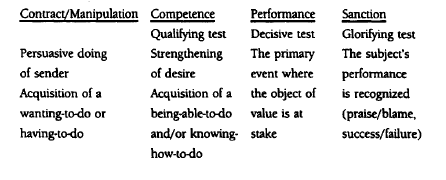


 Grammar
Grammar
 Tenses
Tenses
 Present
Present
 Past
Past
 Future
Future
 Parts Of Speech
Parts Of Speech
 Nouns
Nouns
 Verbs
Verbs
 Adverbs
Adverbs
 Adjectives
Adjectives
 Pronouns
Pronouns
 Pre Position
Pre Position
 Preposition by function
Preposition by function 
 Preposition by construction
Preposition by construction
 Conjunctions
Conjunctions
 Interjections
Interjections
 Grammar Rules
Grammar Rules
 Linguistics
Linguistics
 Semantics
Semantics
 Pragmatics
Pragmatics
 Reading Comprehension
Reading Comprehension
 Teaching Methods
Teaching Methods|
Read More
Date: 2025-05-06
Date: 2025-05-05
Date: 2025-05-05
|
The narrative level
This level is more general and more abstract than the discursive level. It is the level of story grammar or surface narrative syntax, a structure that, according to the Paris School, underpins all discourse, be it scientific, sociological, artistic, etc.
Semiotic analysis of this level of meaning makes use of two fundamental narrative models: (1) the actantial narrative schema and (2) the canonical narrative schema. These models jointly articulate the structure of the quest or, to be more precise, the global narrative programme of the quest. They can be applied to an extract, for example, a single paragraph or to a whole text.
We will first look at the actantial narrative schema. This schema presents six key narrative functions (actantial roles) which together account for all possible relationships within a story and indeed within the sphere of human action in general:
The schema is a simplification of Propp's seven 'spheres of action' or roles elaborated from a study of the Russian folk-tale - such as those of hero, villain, helper, etc. The diagram depicts the following relationships:
1. Subject/object
This is the most fundamental relationship: there can be no subject without an object and vice versa. A subject goes in quest of an object. The object of the quest could be concrete - a person or thing – or abstract, such as knowledge, truth or love.
There is usually more than one subject and more than one quest in, for example, a novel or a newspaper article.
2. Helper/opponent
The subject could be helped or hindered in its quest. Again these actantial positions could be held by objects or internal qualities as well as by people. Money or courage could be my helper and laziness my opponent.
A variant of the opponent is the anti-subject. An anti-subject is a subject who, to achieve its goal, obstructs the quest of another subject. The subject/anti-subject relationship characterizes all fiction and most newspaper articles or TV broadcasts: it is, of course, the hero/villain scenario.
3. Sender/receiver
The sender is an actant (person/idea) that motivates an act or causes something to happen. In other words, the sender provokes action, causes someone to act. The sender transmits to the receiver the desire to act (youloir jaire) or the necessity to act (devoir jaire). We call the desire or obligation to act 'modalities'. What is known as a contract is established between sender and receiver. The receiver, when in possession of one (or both) of the relevant modalities, is transformed into a subject ready to embark on a quest.
We will now look at the canonical narrative schema. This presents in detail the different stages of any quest.

|
|
|
|
"وجه أوزمبيك".. تحذير من عرض غير متوقع لدواء إنقاص الوزن
|
|
|
|
|
|
|
"واتساب" يتوقف عن العمل في 3 هواتف شهيرة.. هل تمتلك أحدها؟
|
|
|
|
|
|
|
مدينة الفردوس الترفيهية توفر أكثر من 60 جلسة عائلية عامة وخاصة
|
|
|